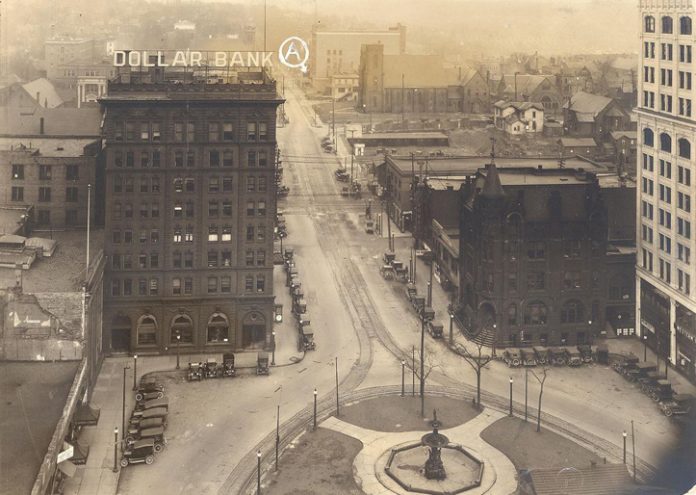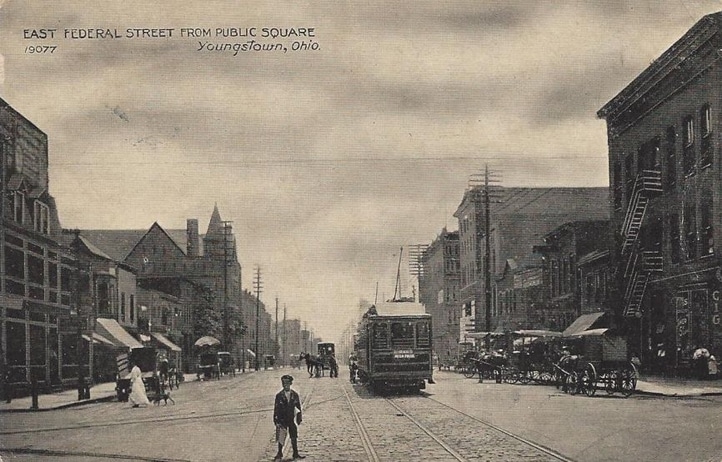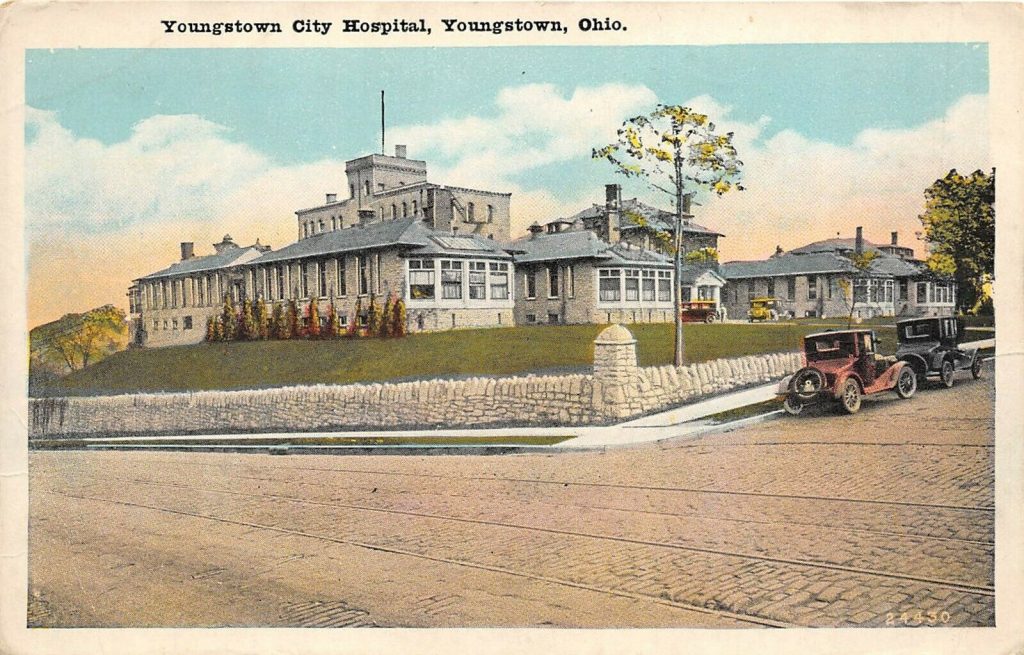
Theaters, cafes, bars and churches closed. A deserted downtown Youngstown with hardly a soul on the street. An order for citizens to stay cloistered in their homes. This could easily describe the Youngstown area in April 2020, but it’s actually a description of the city nearly 102 years ago as the Spanish Flu hung like a black cloud over the Mahoning Valley and the world.
“Pleasures were abandoned, even the most ordinary social amenities were almost foregone,” wrote industrialist Joseph Butler in his 1921 book “History of Youngstown and the Mahoning Valley, Ohio.”
No one from his generation would forget the months of horror in the late fall and winter of 1918. However, until recently, the Spanish Influenza was part of a “collective forgetting in American life,” according to Laura Spinney, author of “Pale Rider: The Spanish Flu of 1918 and How It Changed the World.” The same could be said here in the Mahoning Valley. For the story of the virus in this area isn’t just part of local history – it holds lessons for those of us living through the COVID-19 pandemic today.
The first documented case of what became known as the Spanish Influenza emerged at Camp Funston at Fort Riley in Kansas in March 1918. The infected individual, a base cook, reported having a sore throat, fever and headache. Hundreds more fell ill at the base over the upcoming weeks. Funston funneled rural conscripts into the American Expeditionary Force headed for France, helping to spread the virus. This was the first (comparatively mild) wave of the flu, one that had its biggest impact on the battlefields of Europe, helping to slow the German “Kaiserschlacht” offensive on the Western Front in the spring.
Camp Funston flu ward during the 1918 pandemic, Camp Funston, Kan. (public domain image/U.S. Army)
Unlike the Allied and Central Powers, who censored reporting, neutral Spain freely reported on the outbreak of influenza. This led to the impression that the virus, which became known as the Spanish Flu or Spanish “grippe,” had originated in Spain.
After dissipating during the summer, the virus emerged in Boston in August, bringing a wave of suffering that slowly unfolded during the fall and early winter. Most of the virus’ victims (anywhere from 2.5 to 5 percent of the world’s population) died between mid-September and mid-December, according to Spinney. Reporting in the Vindicator estimated a death rate of between 7 and 10 percent for Ohio during the height of the outbreak.
On Oct. 1, the Chillicothe Gazette reported that 60 percent of the city’s population – located next to Camp Sherman, where influenza raged – was infected. Six days later, the local Czecho-Slovak community held a rally in downtown Youngstown that attracted thousands of onlookers. A large rally held at the South High School auditorium followed.
This event almost certainly facilitated the spread of flu throughout the local community. Three days later the Youngstown Vindicator called the outbreak of influenza in the area an “epidemic unchecked.” Four deaths were reported along with 20 cases at the Glenwood Children’s Home for a total of 71 new cases in one day. At the time of the parade, the local health board had reported only 16 total cases in Youngstown.

The Youngstown Telegram reported a total of 236 cases as of Oct. 11. That same day the board of health announced the closing of all churches, theaters, saloons, banquets, indoor gatherings, dance halls, poolrooms and bowling alleys. They urged street cars to run below full capacity, and the police descended on East Federal Street to try and close coffee houses and saloons that repeatedly refused to heed the order.
Hotels, where many railroad men and itinerant workers lived, remained open. “The only bright spots were the hotel lobbies,” the Vindicator reported. “Traveling men and others living in the hostelries, having nowhere else to go, thronged the corridors and lounging rooms, chatting, reading or smoking. ‘How long do you think this will last?’ was the question asked by them all.”
It didn’t take long for the hospital system to be overwhelmed. At the time, only Youngstown Hospital Association’s facility on Oak Hill and St. Elizabeth’s Hospital on Belmont served the city. Due to a marked lack of hospital beds, South High and Jefferson schools quickly transformed into emergency hospitals. Baldwin Memorial Kindergarten in the downtown became an influenza-maternity ward.

Many professional nurses were in Europe as part of the war effort, and the local Red Cross estimated the city lacked even a quarter of the nursing staff necessary to address the crisis. Much like what is happening now in New York, hospitals in Youngstown and around the country urged nurses to graduate early and work in emergency facilities. Graduate nurses could expect to make $1.50 an hour, undergraduates $1.25 and nurse’s aides $1.
Clergy, teachers and even students volunteered to work in the hospitals. One of the only first-hand accounts we have of that experience comes from Joseph Higley Jr., a student at the time, who told his tale to the YSU Oral History Program in 1977.
“We received the first patient, who was brought in with a dying condition,” Higley told the interviewer. “They had one nurse on night duty. This first patient died. I had the preliminary job of laying him out, washing him and calling the undertaker.”
He estimated that about 90 out of the approximately 380 patients at South High School died. The number included at least three teachers who volunteered to nurse terminally ill patients. “Not one of us boys even got a sniffle from the flu, and yet people were dying all around us,” Higley remembered.
The boys were lucky. Six-year-old Celia Krautheim died at South High only days after her mother, Catherine and 10-year-old brother, Emil. Several officers who survived the war in Europe succumbed at home from flu-related pneumonia. Even Fred S. Bunn, the superintendent of Youngstown City Hospital, died while sick with influenza.
The Vindicator reported 29 deaths on Oct. 30 alone – the height of the epidemic. The names of the dead and their addresses appeared daily in the paper like a grim mantra. No section of the city remained untouched. “Very few homes have escaped from the disease,” the Vindicator reported of the Science Hill neighborhood, “and in some instances whole families are affected.”
“Youngstown’s population was roughly double what it is today,” said Bill Lawson, head of the Mahoning Valley Historical Society. “The neighborhoods were very compact at that time. Living conditions were tight. Large families and multiple families in dwellings.” This proved to be a perfect environment for spreading the flu.
Girard officials called on volunteers to emulate the wartime courage of their “brothers in khaki” and serve in the local emergency hospital. In Lowellville, Sharon Steel Hoop gave its clubhouse over to the village for use as a hospital. One Lowellville resident lost 12 of his family members to the flu. Local quarantine regulations prohibited him from even attending their funerals.
Desperate citizens turned to patent medicines, a common scourge of the era, to ward off influenza. Ads for Hyomei inhalers, basically an antiseptic inhaler containing eucalyptus and advertized as a flu preventative, appeared regularly in the Vindicator. People also melted camphor with lard and rubbed it over their throats, an old-fashioned method of supposedly warding off the flu.
The flu appeared to subside in the city in early November. During a tour of the area, Dr. J. E. Hunter of the U.S. Public Health Service said, “Youngstown is the best organized, in the best shape to handle the epidemic of any city in the state.” South High reported five deaths on Nov. 5, the lowest number in days. Yet any jubilation appeared premature, as the Vindicator reported 233 new cases and 27 deaths on Nov. 8.
Only on Dec. 21 did the city allow theaters to reopen at 80 percent capacity. Seven days later the city lifted the restrictions on businesses and public gatherings. Yet even as the flu dissipated, a crime wave hit beleaguered Youngstown, which the Telegram in turn blamed on chaos caused by the pandemic. The headline “Thugs Unchecked in Vice Carnival” dominated the front page as the year’s end drew near.
There are still similarities and lessons we can glean today from the 1918 influenza pandemic. “Like now, 1918 was a novel H1N1 influenza virus that was spreading across the country,” Lawson said. And just as in 1918, “social distancing” is important.
This is one of the conclusions the National Academy of Sciences came to in a 2007 paper examining the response of various municipalities to the Spanish Flu: “Cities in which multiple interventions were implemented at an early phase of the epidemic had peak death rates ≈ (approximately equal to) 50% lower than those that did not and had less-steep epidemic curves.”
It’s fairly clear that the Czecho-Slovak parade in early October helped spread influenza throughout the Youngstown area. Similarily, in Philadelphia, a Liberty Loan parade held on Sept. 28 attracted an estimated 200,000 people. Within days, over 600 cases emerged, and approximately 16,000 Philadelphians died over the next six months.
And much like in the aftermath of 1918, after the virus reaches its peak in most of America, we may see the periodic reemergence of COVID-19, at least until a workable vaccine is made available.
© 2020 Metro Monthly. All rights reserved.
metro30 podcast #020: “Sean Posey – Spanish Flu Pandemic of 1918”
Mark Peyko and writer Sean Posey discuss why the Spanish Flu pandemic of 1918 is resonating with local readers. Release date: April 11, 2020. Mark C. Peyko hosts.
Metro30 is produced in collaboration with the Youngstown Radio Reading Service. Our podcast is available on iTunes and iHeart Radio. To listen and subscribe, visit:
• iTunes: podcasts.apple.com…
• iHeartradio: www.iheart.com…
***
Metro Monthly is a local news and events magazine based in Youngstown, Ohio. We circulate throughout the Mahoning Valley and offer print and online editions. Be sure to visit our publication’s website for news, features and community events. Office: 330-259-0435.
© 2020 Metro Monthly. All rights reserved.






